Elizabeth Harper
About the Author
Doctor of Historical Sciences, specializing in the economic history of the United States, and holds a degree in numismatics. She is an expert in the valuation of bicentennial quarter 1776 to 1976, knowing everything about design, history and market value. She also specializes in bicentennial quarter silver and other precious metal coins.
Projects and Experience
She pays special attention to coins from the time of the American Revolution, including the bicentennial quarter of 1976. She has thoroughly studied the types of these coins, as well as the bicentennial quarter errors to look for, affecting their value.
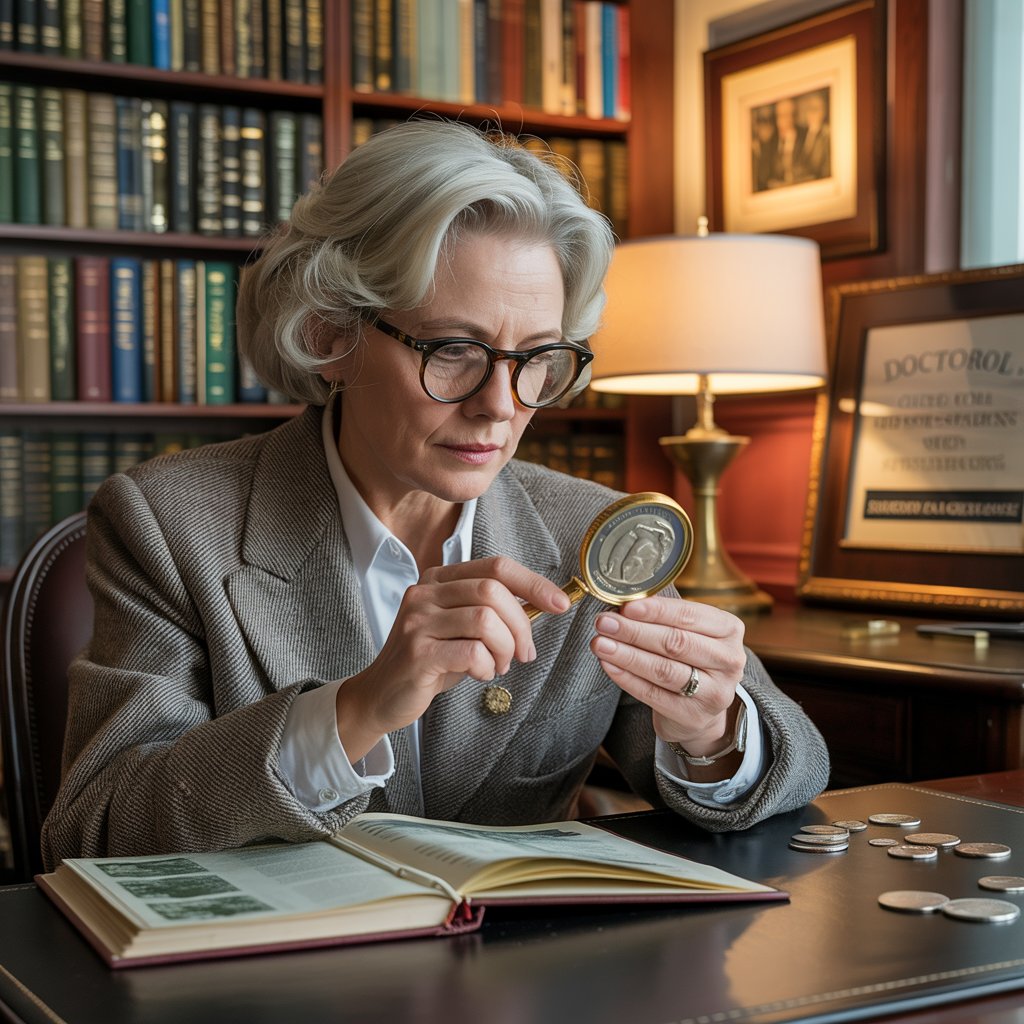
Connect with Elizabeth:



10 Rare Bicentennial Quarter Coins
| Coin Name | Error type | Metal | Rarity |
|---|---|---|---|
| Washington Bicentennial | Inverted Reverse | Copper-Nickel | Very Rare |
| American Silver Eagle | Double Strike | Silver 40% | Rare |
| Bicentennial Eisenhower Dollar | No mint mark (no “S” or “D”) | Copper-nickel | Very Rare |
| Bicentennial Kennedy Half Dollar | Double Engraving | Copper-nickel | Rare |
| 1776-1976 Kennedy Half Dollar | Incorrect date / skewed engraving | Silver 40% | Exclusive |
| Bicentennial Washington Quarter Proof | Alignment error | Copper-Nickel | Rare |
| Bicentennial Quarter with a Doubled Die Obverse | Double Strike | Copper-Nickel | Very Rare |
| Bicentennial Half Dollar with Raised Edge | Minting error | Copper-nickel | Rare |
| Bicentennial Eisenhower Dollar Silver Clad | Incorrect metal marking | Silver plating | Very Rare |
| Bicentennial Mount Rushmore Quarter | Die Chip | Copper-nickel | Very Rare |
What Is a Bicentennial Quarter in Numismatics
The 1976 coins, issued to commemorate the bicentennial of U.S. independence, occupy a special place in the country’s numismatic history. These are not just commemorative coins, they are artifacts embodying the spirit of the American Revolution and the birth of the nation.
Historical value
These coins symbolize a turning point in the history of the United States. They remind us of the struggle for independence and the principles on which the country was founded.
Artistic value
The competition to develop new designs for these coins attracted talented artists and sculptors, resulting in unique and memorable images that differ from traditional American coins.
Why are Collectors Interested in These Coins?
- Unlike many rare and expensive coins, this type of coins are relatively affordable, making them attractive to novice collectors. This is especially true when people are wondering how much is a bicentennial quarter – often the answer turns out to be quite accessible.
- There are several types of these coins, ranging from quarter dollars to dollars, each with its own unique design and characteristics. This diversity allows collectors to create interesting and diverse collections.
- Among coins, there are rare specimens with minting errors, such as double stamps or missing design elements.Special attention is paid to the search for the rare 1976 bicentennial quarter.
- Collectors are also interested in the condition of the coins. Of course, an uncirculated bicentennial quarter will have much more value than a coin in circulation.
- Not only coins in perfect condition are of interest, but also certain varieties, such as bicentennial quarter D mint mark copies issued by a particular mint. These nuances affect the bicentennial D quarter value.
Rare Variants and Errors
It is worth noting that copies of the 1776 bicentennial quarter may have nuances that distinguish them from the 1976 editions.
- How to distinguish an ordinary specimen from a rare one
- In order to distinguish an ordinary specimen from a rare one, it is necessary to carefully study the design details and the mint marks.
- Often, a magnifying glass and reference literature are required to identify rare variants. It is important to know exactly where to look for distinguishing features and which parameters should be compared.
Many people are interested in the bicentennial quarter value no mint mark, and it is important to understand that the absence of a mint mark alone does not always make a coin valuable.
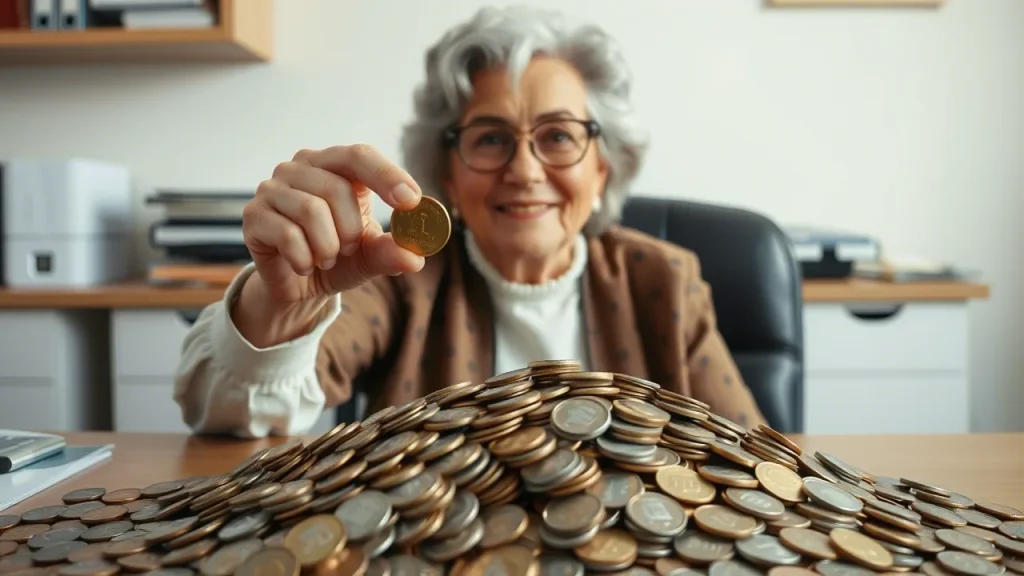
What Makes a Bicentennial Quarter Worth Money
- One of the most famous minting errors is the inverted reverse, when the image on the reverse side of a coin is inverted relative to the obverse.
- A double blow occurs when the stamp hits the coin twice, creating a split image.
- This can be especially noticeable on the letters or on the main elements of the design. Searching for 1976 bicentennial quarter errors list with pictures will help you recognize this and other errors.
- It is these errors and rarities that make bicentennial quarters’ rare value higher. Even minimal deviations from the norm can affect the 1776 bicentennial 1976 quarter value.
10 Most Valuable Quarters
1. Washington Bicentennial Quarter with an Inverted Reverse
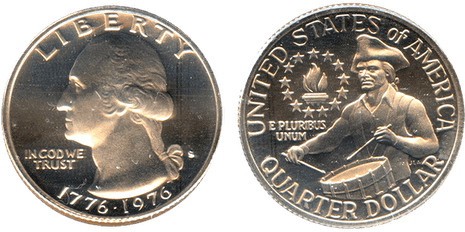
The coin was issued in 1976 in honor of the 200th anniversary of the independence of the United States.
- Inverted reverse occurs when the reverse of the coin is minted at an angle of 180 degrees with respect to the obverse. This means that if you hold a coin by the obverse and flip it vertically, the reverse will be “upside down”.
- It is a great success to find a quarterback with an inverted reverse. The circulation of coins with this error is extremely limited, which significantly increases their value in the numismatic market.
How to determine the authenticity of a coin with an inverted reverse?
To determine the authenticity of the coin, it is necessary to carefully examine it for compliance with the standard characteristics of a quarter (metal, weight, diameter).
Coin Value
People are interested in bicentennial quarter worth money, and this particular instance answers the question in the affirmative.
In good condition, such a quarter can cost significantly more than face value. A search for the 1976 rare bicentennial quarter may lead to this valuable find.
Important notes
Do not confuse coins with an inverted reverse with coins with a slight image offset. An inverted reverse is a clear and obvious 180 degree turn. Not all bicentennial quartered with minor defects are as valuable as this particular copy.
Even if the coin has a double die bicentennial quarter error, the value may be lower than that of the inverted reverse. 1976 bicentennial quarter no mint mark value by itself does not guarantee a high price unless there are other rare characteristics.
2. American Eagle Bicentennial Silver Dollar with a Double Strike

- This silver dollar, issued in honor of the bicentennial of the United States, is in itself of interest to collectors.
- As a rule, the rare error bicentennial quarters value is higher, and this also applies to the silver dollar. A double strike is visible evidence of an error in the minting process, making each copy unique.
- The reference to American history and symbols makes this dollar especially attractive to patriots. Recalling the period 1776 to 1976 bicentennial quarter, this dollar carries the charge of history.
How to recognize a double strike?
Carefully examine the coin, especially the letters and the main design elements (image of an eagle, date). If you see a split, it could be a double whammy. It is better to contact an expert for confirmation. You can often find bicentennial quarter filled worth discussions, but you should pay no less attention to dollars with a double whammy.
Important notes
Many people are interested in the value of quarters with this feature, and although it may affect the price, the double whammy is much more important. For this type of coin, the presence or absence of a yard mark is not a decisive factor, unlike the presence of a double stroke. Coins that are designated as no mint mark bicentennial quarter may be of interest to collectors, but the rarity and value are determined in combination with other factors.
3. Bicentennial Eisenhower Dollar without Mint Mark
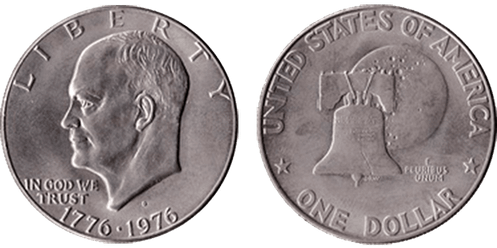
- The absence of a mint mark is a deviation from the norm. This is what attracts numismatists.
- When asked if a bicentennial quarter is worth anything, many people are skeptical, but this dollar is a completely different story. And, of course, another question arises: what bicentennial quarter is worth money, and this dollar is certainly on the list of contenders.
- The lack of a mint mark raises many questions about how and where this coin was minted. This gives her an extra aura of mystery.
How to recognize this rare dollar?
Carefully inspect the coin in the area where the mint mark is usually located (under Eisenhower’s head).
The “empty space” should be exactly where the sign is usually located, and not as a result of erasure. It is such instances that become valuable rare bicentennial quarter coin.
You can find out the 1976 bicentennial quarters coin value, but for a significant amount you need a copy without a mint mark.
4. Bicentennial Kennedy Half Dollar with Double Engraving
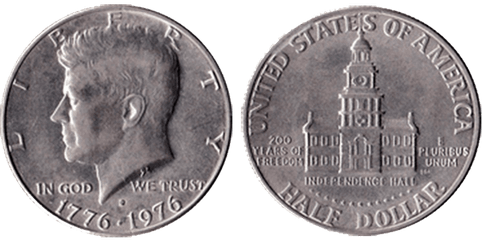
- Unlike ordinary coins, this half dollar has a clearly visible duplication of image elements.
- The Bicentennial Half Dollar with double engraving belongs to the category of rare specimens. Although the copper-nickel alloy does not make a bicentennial quarter rare coins.
1976 bicentennial quarter valued
The value of the coin increases significantly due to the rarity of the error. The silver bicentennial quarter value rarity, of course, plays a role, but the double engraving on the copper-nickel half dollar makes it significantly more valuable than ordinary specimens made of the same alloy.
- Bicentennial quarter value error – half dollar coins with errors, as well as quarters, are the object of close attention of collectors. The size of the error and its visibility directly affect the cost.
- Remember that cost estimation requires a professional approach. Before selling or buying such a coin, contact numismatists or specialty stores for an expert assessment.
5. 1776–1976 Kennedy Half Dollar Proof
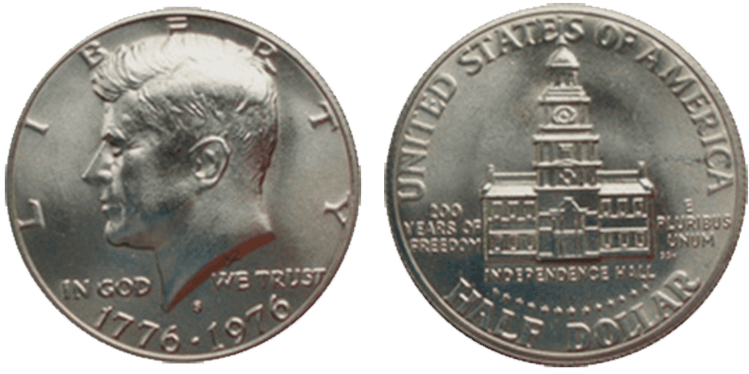
What to look for in the silver field of a half dollar?
- Incorrect date
- Skewed engraving
The rare bicentennial quarter values are nothing compared to the potential cost of this one with a defect.
Why is this half dollar so valuable?
Bicentennial quarter value history shows that commemorative coins, especially those with errors, only grow in value over time. Bicentennial quarter mint mark location: Usually found on the obverse, to the right of the portrait of Washington.
Even a “simple” jubilee ten can be valuable if it has a rare variety or a defect in coinage.
6. Bicentennial Washington Quarter Proof
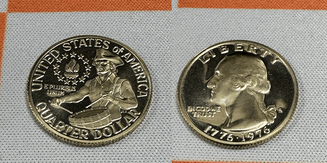
During stamping, the stamp was shifted relative to the blank, as a result of which part of the image may be missing, incomplete or distorted.
Rare bicentennial quarter errors to look for
- Image offset
- Carefully inspect the edges of the coin. If part of the image is missing, cropped, or pushed too far to the edge, this is a clear sign of a centering error.
- Incomplete image
- Metal sticking
The bicentennial quarters mint mark is an important element worth checking out.
What makes a bicentennial quarter valuable?In this case, it is the quality of the coinage and the appearance of error. Heavily offset images with a lot of “missing” metal are valued higher.
7. Bicentennial Quarter with Doubled Die Obverse
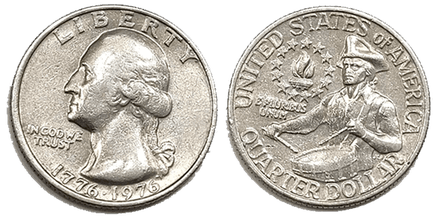
- Imagine an ordinary anniversary quarter, but its obverse seemed to split. A copy with such a mistake is a very rare find and highly desirable for any collector.
- During the manufacture of the obverse stamp, a double blow occurs, in which the image shifts slightly.
The bicentennial quarter with no mint mark may indicate that the coin was minted in Philadelphia. It is important to note that both coins with and without the mint mark may have the Double Die Obverse error.
The error coin bicentennial quarter makes it more valuable, but the double strike of the obverse is one of the rarest and most sought-after.
Also, do not confuse it with the bicentennial quarter filled D error, which is another, less common error related to filling the space inside the letter “D” with the Denver Mint mark.
8. Bicentennial Half Dollar with Raised Edge
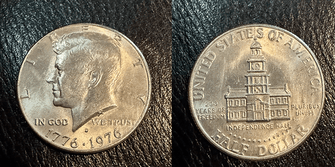
This minting error turns the coin into a rare and coveted object for collectors.
What does the “protruding border” on a half dollar mean?
During the minting process, due to a malfunction in the equipment or the use of a defective stamp, the edge of the coin turns out to be uneven, with a protruding border, like a rim encircling the image.
- Bicentennial quarter value rare coins with errors are of the greatest interest to collectors.
Is bicentennial quarters worth anything?
In this case, yes. Ordinary commemorative coins in mass circulation are not of great value, but defective copies are a completely different story.
9. Bicentennial Eisenhower Dollar Silver Cloud
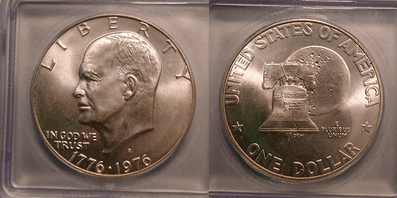
A mistake in labeling the metal turns the dollar into a very rare find that collectors are after.
What does the mislabeling of the metal on the Eisenhower silver dollar mean?
- There is no indication of the silver content on the coin at all.
- It is indicated that the coin is made of another metal, for example, a copper-nickel alloy, although in fact it is a silver treasure.
- The marking is present, but has defects or damages.
Rare bicentennial quarters value the value of rare commemorative quarters is certainly important, but the value of an Eisenhower dollar with a metal labeling error can be significantly higher.
Valuable 1976 bicentennial quarters the year of issue is important, but it is the unique mistake that makes the coin valuable.
10. Bicentennial Mount Rushmore Quarter with Die Chip
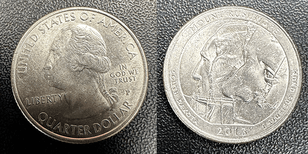
The Mount Rushmore commemorative quarter, dedicated to the bicentennial of the United States, may turn out to be not just a beautiful coin, but a real treasure.
What is a “Die Chip”?
This is a defect that occurs on a coin stamp during its manufacture or operation. A small piece of metal breaks off from the stamp, as a result of which a small “bump”, “protrusion” or “track” appears on the minted coins coming from any element of the image.
Bicentennial quarter rate value
Ordinary anniversary quarters don’t have much value, but copies with rare errors, such as Die Chip, can be very expensive. It is the bicentennial quarter error coin that makes the coin valuable.
Which bicentennial quarter is worth money?
In this case, when there is a rare and well-marked error. The chip engraved on the jubilee quarter with Mount Rushmore makes it one of the most coveted items for collectors.
Frequently Asked Questions
How Much Is a Bicentennial Quarter Worth Millions?
The real cost of an anniversary quarter in millions of dollars is most likely a myth or an exaggeration. Although there are rare instances with unique errors that can cost thousands or tens of thousands of dollars, million dollar estimates for a Bicentennial Quarter are highly unlikely. Where Is the Mint Mark on a Bicentennial Quarter?
The Mint mark (P, D, or S) on the Bicentennial Quarter is located on the obverse (obverse) of the coin, to the right of George Washington’s neck, under the inscription “IN GOD WE TRUST.” The coins minted in Philadelphia (P) in 1975-1979 did not have a mint mark.
Where is the Bicentennial Quarter Coin Sale Taking Place?
Commemorative quarters are actively sold and bought at numismatic auctions, online stores and from private collectors. Prices vary depending on condition, rarity, and the presence of errors.
Are Bicentennial Quarters Worth Anything
As already mentioned, ordinary Quarters in circulation have little value other than nominal value. However, rare varieties, coins in excellent condition (UNC) and copies with minting errors may be of interest to collectors and cost significantly more.
What is the Bicentennial Quarter $90 Million?
Information about the sale of the jubilee quarter for $ 90 million is most likely unreliable. This is either misinformation or a gross mistake. A rare bicentennial quarter of $11 million is also impossible.
What Does a Bicentennial Quarter Look like?
Bicentennial Quarter has a number of distinctive features.
Obverse: Portrait of George Washington, inscriptions “LIBERTY” and “IN GOD WE TRUST”, as well as the double date “1776-1976”.
Reverse: Image of a colonial drummer and a burning torch, inscription “UNITED STATES OF AMERICA” and denomination “QUARTER DOLLAR”.
How Many Bicentennial Quarters Were Made?
In total, more than 1.6 billion commemorative quarters have been issued, which makes them quite common.
What Bicentennial Quarter Is Worth $20,000?
For a Bicentennial Quarter to be worth $20,000, it must have a rare combination of factors. Exceptional condition (MS67 or higher)
The coin should be almost perfect, without any signs of wear.
The coin must have a unique and well-defined error, such as a double stroke, an inverted reverse, or the absence of a mint mark.
Which Bicentennial Quarters Are Worth Money?
Rare specimens with minting errors, especially in good condition.
Coins in an Uncirculated state that have never been in circulation.
Silver Bicentennial Quarters, minted in San Francisco
What Is the Value of a Bicentennial Quarter?
The cost of a Bicentennial Quarter depends on its condition, rarity, and the presence of errors. Ordinary coins are worth their face value (25 cents), and rare copies can cost thousands or even tens of thousands of dollars.